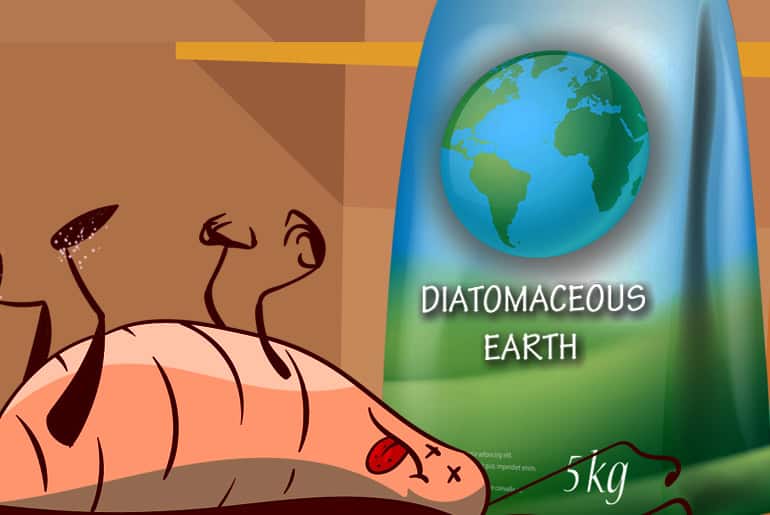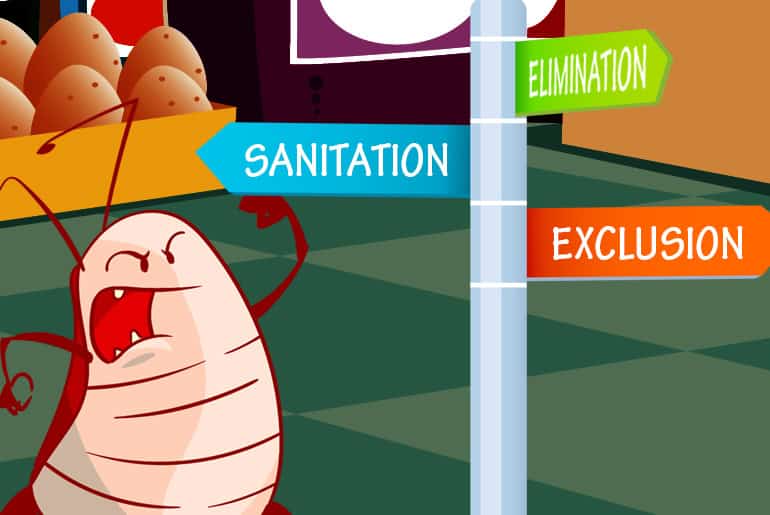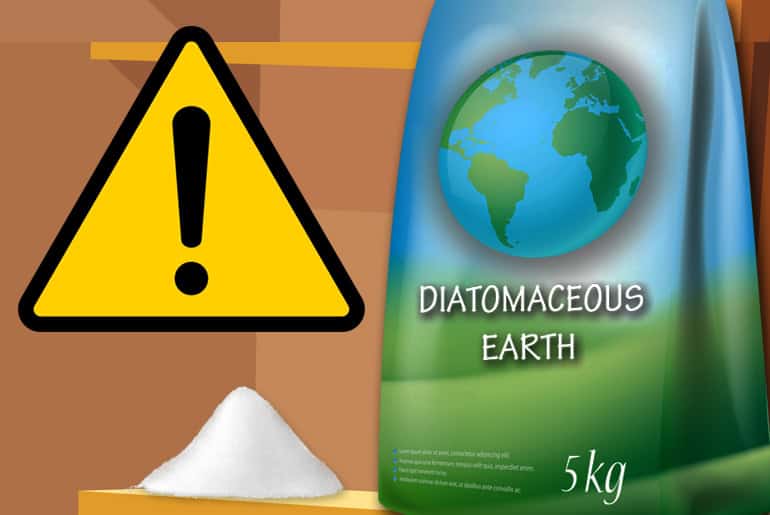Cockroach Facts is a participant in the Amazon Services LLC Associates Program, an affiliate advertising program designed to provide a means for sites to earn advertising fees by advertising and linking to Amazon.com.
Finding even a single cockroach in your home can mean a serious situation. If you’ve discovered one, you’ll want to move fast, beginning with the crucial first step: Identification.
In this short guide, you’ll learn about the 6 types of roaches (with pictures for easy identification) likely to have invaded your home – step #1 in your cockroach battle plan.
Need Product Recommendations?
A handful of easy-to-use products can solve most cockroach problems.
Ready? Let’s get to work.
The Different Types of Cockroaches
German Cockroaches

German cockroach pictures

via Daniel R. Suiter, University of Georgia 
via Michael Merchant, Texas Cooperative Ext. 

via Gary Alpert, Harvard University
About:
The German cockroach, Blattella germanica, is the most common nuisance cockroach that people find in their homes. It prefers houses and buildings to any other habitat and reproduces faster than other cockroach species. It’s especially problematic in apartments and other types of shared living spaces.
Though they have wings, they don’t fly; instead, they use their wings to glide. German cockroaches are dangerous in homes because they can spread disease by contaminating food and cooking surfaces. Furthermore, they shed periodically and leave behind egg casings that can cause asthma attacks and trigger allergies.
Appearance:
German roaches are relatively small—approximately 0.5 inches long. An adult German cockroach is light brown and has two dark stripes running down its thorax (the middle section of its body). A juvenile (called a nymph), on the other hand, is smaller, darker colored, and has a tan stripe running down its back.
Geographic Range
German cockroaches live in many environments worldwide. They can live outdoors in the tropics but prefer to find shelter in people’s homes in cooler climates.
Mode of Entry
Often, German cockroaches are accidentally brought into homes on furniture or in grocery bags, shipping boxes, and drink cartons. In apartment buildings, they can crawl through shared pipes and ducts to infest additional units and quickly become a widespread problem.
Preferred Locations
You’ll most likely find German cockroaches hanging out in your kitchen, bathroom, or any place where food is stored or prepared. They are especially fond of humid areas with temperatures between 70 and 75oF.
These roaches can squeeze into cracks and crevices to hide near food, water, and sources of heat. If their populations become too large, you might begin to find them in other parts of your home, including bedrooms and closets.
Habits and Reproduction
German cockroaches eat a variety of household items, including book bindings, crumbs, soap, toothpaste, and other scavenged items.
Female German cockroaches lay egg cases, called oothecae, that can contain 30 to 40 eggs each. They produce these egg cases every few weeks (more often during warm weather). On average, a German cockroach lays between 4 and 8 oothecae in its lifetime.
Don’t expect to find these egg cases easily, though: females carry them around until 1 to 2 days before they hatch. Sometimes, a female estimates incorrectly and the eggs hatch while she’s still carrying the ootheca.
A single German cockroach can be responsible for the births of more than 30,000 babies in one year. Typically, nymphs mature in 40 and 125 days. Though not all will survive to adulthood, these cockroaches’ rapid cycles of growth and reproduction can cause infestations to grow and spread quickly. Making proper roach control extremely important.
American Cockroaches

American cockroach pictures
About
The American cockroach, Periplaneta americana, (also known as the palmetto bug or sewer roach) is also quite common in homes and apartments. However, this roach species prefers the outdoors and is less likely to infest living spaces than German cockroaches. Like German cockroaches, the American roach can spread disease and trigger allergies and asthma. They move rapidly but don’t often use their wings to fly.
Appearance
At up to 2 inches in length, American cockroaches are the largest of the common roaches. Their color is reddish-brown, with a light yellow band outlining their thorax. It’s easy to tell the difference between adults and nymphs because the adults are larger and have wings, while nymphs don’t have wings.
Geographic Range
Despite their name, American cockroaches are native to the African tropics. Today, however, they’re located throughout the United States.
Mode of Entry
American cockroaches typically enter homes through piping from sewers or similar locations. They can crawl through small gaps around windows, doors, or vents to find shelter. They can also enter homes as stowaways in piles of firewood.
Preferred Locations
American cockroaches often live in sewers, storm drains, steam tunnels, water meter boxes, gardens, trash bins, and facilities that raise animals. They like warmth and humidity, especially temperatures above 82 F. Indoors, they hide in laundry rooms, boiler rooms, bathrooms, and kitchens. Though they sometimes infiltrate homes, it’s more common to find infestations in grocery stores and restaurants.
Habits and Reproduction
Female American cockroaches carry their oothecae for around 6 days before attaching them to the inner surface of a crack or crevice. Each ootheca contains about 12 to 16 eggs, which might not hatch for 2 months or longer. In a single year, a female can be responsible for more than 800 individuals.
The nymphs mature more slowly than those of other roach species, taking between 65 and 400 days.
American cockroaches prefer a diet of decaying organic matter, but will also eat just about anything, including crumbs and household scraps. Outdoors, they feed on leaves, wood, fungi, algae, and smaller insects.
Oriental Cockroaches

Oriental cockroach pictures
About
The Oriental cockroach, Blatta orientalis is a dangerous pest that mostly lives outdoors. They are most common in homes that have a lot of vegetation around them. They don’t move as fast as other kinds of roaches and don’t fly. Unable to climb smooth vertical surfaces, they often become trapped in sinks and bathtubs.
Oriental cockroaches are even more unpleasant than other cockroach species because of their diet: garbage, feces, and decaying plant and animal matter.
They stink, too. They spend a lot of time crawling over fecal matter, rotting things, and other bacteria-laden material as they search for food (making them potentially more dangerous than other types of cockroaches). They’ll contaminate food, food preparation areas, and utensils simply by walking over them. Luckily, their odor is strong enough to warn you that your food has been contaminated.
Appearance
Oriental cockroaches are larger than German cockroaches but smaller than American cockroaches, measuring about an inch in length. They’re shiny, and dark brown to black in color. While both males and females possess wings, the wings of female Oriental cockroaches are rudimentary. Males’ wings, meanwhile, are about 25% shorter than their bodies. Nymphs look like small, wingless females.
Geographic Range
The Oriental roach lives in coastal areas worldwide. In the United States, it’s predominantly found in southern, northwestern, and Midwestern states.
Mode of Entry
Oriental cockroaches typically enter homes through gaps around windows, doors, and vents. Some come in through sewer pipes or drains that run through walls to the outside. They might also ride along on firewood from a woodpile they’ve been living in.
Preferred Locations
Oriental cockroaches are often found in cool (below 84 F), damp, dark locations, including woodpiles, trash bins, garages, and basements. They also live among ivy and ground cover, inside meter boxes, and in sewers and drains. These roaches are resilient, and can survive quite well in cooler temperatures.
Indoors, you might find Oriental cockroaches in sink cabinets (especially if pipes are leaking), beneath appliances, and within floors5.
Habits and Reproduction
During the day, they tend to remain outside, sometimes entering homes at night to forage.
Oriental cockroaches mature slowly—sometimes, it takes over two years for a nymph to reach adulthood. However, they only live around 180 days. Females carry their ootheca for about a day before depositing it in debris or food. An Oriental cockroach ootheca contains about 16 eggs. Altogether, one female can produce up to eight egg cases, and up to 200 new roaches in a year.
Wood cockroaches

Wood cockroach pictures
About
There are 12 species of wood cockroach (Parcoblatta), including the Pennsylvania wood cockroach, the Virginia wood cockroach, the Boll’s wood cockroach, and the Broad wood cockroach. All thrive in moist woodlands but can also be found in homes occasionally. Houses situated near forests are especially at risk during the spring and summer. Since they feed on dead wood and other materials, these cockroaches are sometimes brought inside with firewood. However, they can’t survive for long indoors.
Wood cockroaches are different from other cockroach breeds in their attraction to light. Only the males can fly short distances. Like other types of roaches, wood cockroaches can contaminate food and trigger allergies and asthma.
Appearance
Wood cockroaches are about 1 inch long and brown. The edges of some wood cockroaches’ wings are white. Females’ wings are shorter than males’—only about 0.5 inch long. Nymphs, which are smaller than adults, completely lack wings.
Geographic Range
Native to North America, the wood cockroach is found across much of the United States, though it’s less likely to be found in the central part of the country. It also lives in Canada and Mexico.
Mode of Entry
Wood cockroaches infiltrate homes through gaps around windows, doors, and vents during the spring and summer. In the cooler months, they hitch rides on firewood. It’s important to always check your firewood for roach eggs before bringing it into your home.
Preferred Locations
Wood cockroaches are most often found in woodpiles and under the bark of fallen logs and dead trees. Sometimes they congregate near homes in gutters and crawl spaces.
Habits and Reproduction
The diet of wood cockroaches primarily consists of decaying organic matter.
Females deposit their oothecae under the bark of dead trees and fallen logs. The eggs hatch about a month later. Wood cockroaches typically only live for a few months.
Smokybrown Cockroaches

Smokybrown Cockroach Pictures
About
The smoky brown cockroach, Periplaneta fulginosa, is very sensitive to dehydration and must live near a reliable source of water. It’s a nocturnal creature and will fly away if disturbed. Like the wood cockroach, smoky brown cockroaches are attracted to light.
Appearance
Smokybrown cockroaches are relatively large—approximately 1.5 inches long. They are dark brown to mahogany-colored with a thorax that looks almost black. You can distinguish them from some other types of roaches by looking at their wings, which are longer than their bodies.
Geographic Range
Smokybrown cockroaches are found in the southeastern United States.
Mode of Entry
Smokybrown cockroaches typically climb into homes through vents and plumbing, especially where vegetation touches the home.
Preferred Locations
An outdoor type of roach, they prefer to hang out in gutters, planter boxes, and woodpiles. They also live beneath shingles and siding, inside water meter boxes, in garages, and amongst trees, shrubs, and other vegetation. Sometimes, they even live in sewers. It’s rare but these cockroaches do occasionally enter homes. Then, they’re typically found in attics.
Habits and Reproduction
Females carry their oothecae for a day before depositing them. It takes about 45 days for the 20 or so nymphs to hatch.
Brownbanded Cockroaches

Brownbanded cockroach pictures
About
The brown banded cockroach, Supella longipalpa, prefers indoor spaces, but is less common than the German cockroach. While females can’t fly, males sometimes flying away from disturbances (though they’re more likely to jump).
Brownbanded cockroaches have a wide-ranging diet, consuming garbage as well as human food. They’re a dangerous pest inside homes because they’re likely to spread bacteria and other contaminants to food and food preparation areas. They also leave behind old skin and egg cases that can trigger allergies and asthma attacks.
Appearance
Brown banded cockroaches have narrow bodies. They’re about 0.5 inches in length (the adult males longer than the females) and have light brown or yellow bands on their abdomens, wings, and the sides of the thorax. Males and females are different colors: males appear to be golden-tan while females are a darker brown.
Males’ wings are longer than their bodies, while females’ wings cover only part of the abdomen. The nymphs are smaller and have two light horizontal bands on their bodies5.
Geographic Range
Brown banded cockroaches live across most of the United States.
Mode of Entry
Like German cockroaches, brown banded cockroaches typically get into homes through furniture, grocery bags, food containers, and electronics. They can move between apartment units via shared duct work and piping and can quickly become a serious problem in apartment complexes.
Preferred Locations
You’re most likely to encounter brown banded cockroaches in locations that are warm (around 80oF), dry, sheltered and higher up, often out of reach. You should inspect around electrical appliances (often in kitchens), beneath clutter, behind wall decorations, and within hollow furniture legs.
Brown banded cockroaches live most commonly in homes that lack air conditioning. They’re also frequently a nuisance in offices or places where lots of paper is stored.
Habits and Reproduction
Brown banded cockroaches and German cockroaches don’t get along; they typically don’t share habitats. Brown banded roaches are nocturnal and don’t seem to care about what they eat, consuming a wide variety of materials, from human food and garbage to fabric (including clothing and curtains), to glue, and even wallpaper.
Brown banded cockroach oothecae contain between 13 and 18 eggs each. Females carry them for about a day to a day and a half, then attach them to ceilings (often in closets) or the undersides of furniture. The oothecae then remain for around 50 days until the eggs hatch.
Brown banded cockroaches have an average lifespan of 13 to 45 weeks. A single female will produce about 14 oothecae in her lifetime, each containing about 13 eggs.
Australian cockroach

Australian cockroach pictures

via Whitney Cranshaw, Col. State Univ. 
Pest & Diseases Img Library, Bugwood.org 
Pest & Diseases Img Library, Bugwood.org 
via Whitney Cranshaw, Col. State Univ.
About
The Australian cockroach, Periplaneta australasiae, is a species of cockroaches that typically lives outdoors but does occasionally invade people’s homes. It’s large and has long wings that let it fly short distances. Due to its appetite for dead and decaying things, it can pick up bacteria and contaminate your counter tops and pantry foods if it gets inside.
Appearance
Australian cockroaches are similar in size to American cockroaches. You can tell them apart by looking for the distinctive tan ring-like pattern on an Australian roach’s back, just below its head.
These cockroaches grow to about 1 ¼ inches long. They’re one of the biggest bugs you’re likely to find crawling around your house. Don’t be scared—they’re not out to hurt you! They spend almost all of their time hiding.
Geographic Range
The Australian cockroach is distributed globally. In the U.S., the largest populations are located in southern states. They’ll build colonies in tree trunks, piles of wood, water pipes and other damp areas.
Mode of Entry
Australian cockroaches come into homes and other buildings through tiny holes in exterior walls and spaces where a pipe or wiring enters. They hang out in garden mulch and piles of leaves, so they’re already close to your house. As soon as temperatures drop, they’ll look for ways inside.
Preferred Locations
Australian cockroaches mostly live outdoors in warm climates. Their favorite habitats have lots of humidity and high temperatures. Sometimes, they infest greenhouses but don’t pose much of a threat to crops.
They’ll come indoors when temperatures drop too low outside. You might find them in sinks and bathtubs or hiding in cabinets and drains.
Habits and Reproduction
Females hide their egg cases in wet woodpiles and crevices near food and water. Nymphs grow over a period of 6 months to a year. As they grow larger, they molt their old exoskeleton and grow a new one.
They go through several molting stages before reaching adulthood. Adult Australian cockroaches live up six months. A single roach can lay over 20 egg cases and produce hundreds of nymphs in its short lifespan.
Asian cockroach

Asian cockroach pictures

Johnny N. Dell, Bugwood.org 
Johnny N. Dell, Bugwood.org 
Natasha Wright, Cook’s Pest Control 
Natasha Wright, Cook’s Pest Control
About
The Asian cockroach, Blattella asahinai, is kind of like the secret twin of the German cockroach. They’re so similar in appearance that even professionals mistook them for German roaches when they were first discovered. Sometimes, they still do!
Appearance
The Australian cockroach is a tiny bug (a little over 1/2 inch long) whose color is mostly light brown. It also has a noticeable pair of dark (almost black) stripes running down its back from its head to the tip of its abdomen. Around these dark strips, it’s body looks like it’s bordered in white.
Geographic Range
The Asian cockroach is a southern species in the U.S. Its biggest populations are in Florida and the surrounding states. Like many people who move to those states, it lives there because of the warmth and humidity.
Mode of Entry
Asian cockroaches are crazy about lights and use their powerful wings to fly toward any nearby light sources. This is the most common reason they enter homes. Otherwise, they’re generally pretty happy staying outside.
You might also run into these cockroaches in your garage or shed since they can easily fit through the gap beneath a garage door or a hole in a shed wall.
Preferred Locations
Asian cockroaches mostly live outdoors in mulch and the shaded areas of people’s lawns. Like other roaches, they feed on decomposing material and garbage, among other things. This leads them to compost piles and landscaping cluttered with leaves or damp mulch.
If they come indoors, they’ll fly toward lights and TV screens. They’ll usually hide close to food sources or in areas with the highest humidity.
Habits and Reproduction
The Asian cockroach feeds on just about anything, from food and garbage to decomposing leaves and other dead insects. Once Asian cockroaches infest an area, they quickly push out any other cockroach species.
Female Asian cockroaches lay about 37 eggs in each egg case they produce. Despite an average lifespan of under 6 months, these roaches still manage to reproduce and spread quickly.
Adult populations are largest during the late summer. In some parts of Florida, hundreds of thousands of Asian cockroaches have been found in a single acre.
Suggested Products If You Have a Roach Problem
To Find Cockroach Hiding Spots and Kill Them Quickly When You Have Just a Few
Recommended for all cockroaches
To Kill Cockroaches Inside Your Home When You Have a Serious Problem
Recommended for German cockroaches and Brown banded cockroaches, as well as American cockroaches (Palmetto bugs, Water bugs, Tree roaches, Sewer roaches), and Oriental cockroaches when they enter in large numbers.
Rockwell Labs CimeXa Dust Insecticide
CimeXa is an effective indoor crack and crevice treatment. For best results, use alongside Advion Gel Bait and Gentrol IGR.
HARRIS Diatomaceous Earth Powder Duster
Insecticidal dusts like CimeXa work best when applied with a duster tool. This inexpensive diatomaceous earth duster works fine with CimeXa, Delta Dust, and other recommended dusts.
Syngenta Advion Cockroach Gel Bait
Advion first poisons the roaches that eat it, then others in a secondary kill. For the most effective indoor treatment, combine with CimeXa insecticidal dust and Gentrol IGR.
Gentrol Point Source IGR
Gentrol is an insect growth regulator (IGR) that interferes with roach reproduction. It’s most effective used alongside Advion Gel Bait and CimeXa insecticidal dust.
To Kill Cockroaches Outdoors Before They Have a Chance to Get Inside
Recommended for American cockroaches (Palmetto bugs, Water bugs, Tree roaches, Sewer roaches), Oriental cockroaches, and Smokybrown cockroaches.
Bayer Polyzone Suspend Insecticide
When used on exterior foundations, entries, and walls, Suspend insecticidal liquid stops outdoor roaches before they get in. It requires a separate sprayer (see below), and works best alongside a granular outdoor bait like Intice and an outdoor crack and crevice treatment like Delta Dust.
InTice Perimeter Insect Control Bait Granules
InTice is a granular bait that kills roaches outdoors and in spaces like your garage or attic. Used alongside a spray treatment like Bayer Suspend and a crack and crevice treatment like Delta Dust, it can protect the entire perimeter of your home.
Conclusion
The first step in any pest control strategy is to find out exactly what you’re up against. Here, we’ve covered important details about the six different types of cockroaches you’re most likely to run into in or around your home.
With this information, you’ll be able to identify the types of roaches you see and find where they’re hiding. You’ll also know how dangerous they might be and how serious the problem is. Armed with this knowledge, you’re ready to tackle your cockroach problem head-on.
Good luck!
Frequently Asked Questions
There are more than 4500 different types of roaches. Of those, only 69 species are found in the United States (10 in Canada), and only 30 are considered pests.
Some roaches fly. Others don’t. Of those that do, there’s a big difference in flying ability. Asian, Smokybrown, Australian, and wood roaches are pretty good fliers, while American cockroaches really just use their wings to glide.
Only a handful of cockroach species wind up inside our homes, and an even smaller number actively try. While wood roaches typically get in by accident, and American and Oriental roaches typically enter when there’s a change in environment outdoors, German and Brownbanded roaches will actively try to infest your home.
Of the scores of cockroaches that inhabit North America, just a few are considered dangerous due to the filth they live in and the threat of contamination they pose. The roaches which pose the highest risk to human health are the German, American, Oriental, and Brownbanded species.
Written by Andrew Martin. Reviewed by Rae Osborn, PhD.

Andrew Martin
Writer/Publisher
Andrew writes for, and along with his daughter, publishes Cockroach Facts. You can read more about him here.

Rae Osborn, PhD.
Science Editor
Dr. Rae Osborn holds Honors Bachelor of Science degrees in Zoology and Entomology, and a Master of Science in Entomology from the University of Natal in South Africa. She holds a PhD in Quantitative Biology from the University of Texas at Arlington, where her research was in Entomology. You can learn more about our contributors here.
Sources:
- Rust, M.K. and Reierson, D.A. (2007) Cockroaches. Pests of Homes, Structures, People, and Pets. Retrieved from http://ipm.ucanr.edu/PMG/PESTNOTES/pn7467.html.
- Potter, Michael F. (2018) Cockroach Elimination in Homes and Apartments. Entomology at the University of Kentucky. Retrieved from https://entomology.ca.uky.edu/ef614.
- Hahn, Jeffrey and Ascerno, Mark. (2018) Cockroaches. University of Minnesota Extension. Retrieved from https://extension.umn.edu/insects-infest-homes/cockroaches.
- McLeod, Robin. (2005) Genus Parcoblatta – Wood Cockroaches. BugGuide. Retrieved from https://bugguide.net/node/view/31624.
- Wood Cockroach (n.d.) Iowa State University Extension and Outreach. Retrieved from https://hortnews.extension.iastate.edu/wood-cockroach
- University of Georgia’s Center for Invasive Species and Ecosystem Health (Bugwood Images collection).





































































































